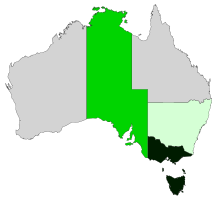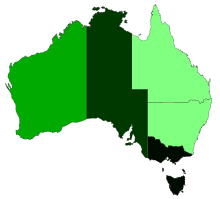1898–1900 Australian constitutional referendums
Politics of Australia |
|---|
 |
|
Constitution |
|
A series of referendums on the proposed constitution of Australia were held between 2 June 1898 and 31 July 1900 in the six colonies that were to become the states of the Commonwealth of Australia.[1] The first four referendums were held in New South Wales, South Australia, Tasmania and Victoria in June 1898.[1] Although all four saw a majority vote in favour, the majority in New South Wales was insufficient.[1] Knowledge of the result in New South Wales led to low voter turnout in South Australia.
Following a series of amendments made to the proposed constitution at the Secret Premiers meeting on 31 January and 1 February 1899, a second referendum was required in the four states, whilst on 2 September, Queensland held a referendum on the constitution for the first time. All five states saw a majority vote in favour.
Three weeks after the Commonwealth of Australia Constitution Act became law in 1900, Western Australia held a referendum on the constitution,[1] which was also approved. The constitution came into force on 1 January 1901.[2]
Background[]
The revival of the federal movement stemmed from the growth of federal leagues and nationalist organisations that were committed to federation, such as the Australian Natives' Association. There were two so-called People's Conventions held in Corowa and Bathurst.

In 1893 John Quick, who had attended the Corowa convention, drew up a bill which became the basis of discussion at the Adelaide Convention (see below) and is considered to have contributed largely to the eventual constitution. Quick with Robert Garran went on to publish The Annotated Constitution of the Australian Commonwealth in 1901, which is widely regarded as one of the most authoritative works on the Australian Constitution.[3]
In 1895 a proposal was accepted by the premiers of the Australian colonies to establish a new Convention by popular vote, with the resulting draft of the constitution being submitted to the electors of each colony in a referendum. The Convention held meetings over the course of a year, beginning first in Adelaide in 1897, later meeting in Sydney, and culminating in Melbourne in March 1898. After the Adelaide meeting, the colonial Parliaments took the opportunity to debate the emerging Bill and to suggest changes. The basic principles discussed in 1891 were adopted, with the addition of the principle of responsible government. There was also a consensus for more democracy in the constitutional structure. It was agreed that the Senate should be chosen by popular vote with the voters in each State acting as one electorate.
A draft bill was drawn up in 1898, and then sent to each colony to be ratified by the electorate. Referendums were held in four of the colonies in June 1898. There were majority votes in all four of them, however, the enabling legislation in New South Wales required the support of at least 80,000 voters for passage, and this number was not reached.[4] A meeting of the colonial premiers in early 1899 agreed to a number of amendments to make the constitution more acceptable to New South Wales. Known as the "Braddon Clause", the amendments provided for the return of customs revenue to the states for ten years. It was also agreed that the new federal capital was to be built in New South Wales provided it was at least a hundred miles (160 km) from Sydney.[4] In June 1899, the referendum was held again in all the colonies except for Western Australia, where the vote was not held until the following year. The majority vote was "yes" in all the colonies.South Australia[]
Residents of South Australia were staunchly opposed to federation in the mid-19th century due to the dominance of the colonies of Victoria and New South Wales in issues such as trade and tariffs, as well as a desire to keep unique elements of South Australia intact.[5] The mood had shifted by the 1890s, with what was seen as the looming inevitability of federation a motivator to negotiating a good deal for the less populous colonies, with the argument by the Yes campaign that they may never have such favourable terms again.[6] The No campaign however focused on the potential for increased costs for South Australians, as well as decreased land values.[7]
Results[]
1898 referendums[]

| State | Date | For | Against | Turnout | |||
|---|---|---|---|---|---|---|---|
| Vote | % | Vote | % | Vote | % | ||
| Tasmania | 3 June 1898 | 11,797 | 81.29 | 2,716 | 18.71 | 14,513 | 25.0 |
| New South Wales [a] | 4 June 1898 | 71,595 | 51.95 | 66,228 | 48.05 | 137,823 | 43.5 |
| South Australia | 4 June 1898 | 35,800 | 67.39 | 17,320 | 20.54 | 53,120 | 30.9 |
| Victoria | 4 June 1898 | 100,520 | 81.98 | 22,099 | 18.02 | 122,619 | 50.3 |
| Source: Federation Fact Sheet 1 – The Referendums 1898–1900, AEC | |||||||
1899 and 1900 referendums[]

| State | Date | For | Against | Turnout | |||
|---|---|---|---|---|---|---|---|
| Vote | % | Vote | % | Vote | % | ||
| South Australia | 29 April 1899 | 65,990 | 79.46 | 17,053 | 20.54 | 83,043 | 54.4 |
| New South Wales | 28 June 1899 | 107,420 | 56.49 | 82,741 | 43.51 | 190,161 | 63.4 |
| Tasmania | 27 July 1899 | 13,437 | 94.40 | 797 | 5.60 | 14,234 | 41.8 |
| Victoria | 27 July 1899 | 152,653 | 93.96 | 9,805 | 6.04 | 162,458 | 56.3 |
| Queensland | 28 September 1899 | 38,488 | 55.39 | 30,996 | 44.61 | 69,484 | 54.4 |
| Western Australia | 31 July 1900 | 44,800 | 69.47 | 19,691 | 30.53 | 64,491 | 67.1 |
| Source: Federation Fact Sheet 1 – The Referendums 1898–1900, AEC | |||||||
Notes[]
- ^ The enabling legislation in New South Wales required a minimum of 80,000 votes in support.
References[]
- ^ a b c d Commonwealth of Australia Constitution Act 1900 (UK) Museum of Australian Democracy
- ^ Australia, 31 July 1900: Constitution Direct Democracy (in German)
- ^ "Closer Look: The Australian Constitution". Parliamentary Education Office. Archived from the original on 5 April 2012. Retrieved 9 April 2012.
- ^ a b "Celebrating Federation" (PDF). Constitutional Centre of Western Australia. Retrieved 5 November 2015.
- ^ David Brooks; Dr Zoe Gill; Dr John Weste (eds.). "South Australian Referenda, 1896-1991" (PDF). Archived from the original (PDF) on 2015-04-09. Retrieved 6 December 2011.
- ^ "Commonwealth League Advertisement". Retrieved 6 December 2011.
- ^ "Anti-Commonwealth Bill League Advertisement". Retrieved 6 December 2011.
- 1898 elections in Australia
- 1899 elections in Australia
- 1900 elections in Australia
- 1898 referendums
- 1899 referendums
- 1900 referendums
- Constitutional referendums in Australia
- 1890s in South Australia
- 1900s in South Australia
- 1890s in Tasmania
- 1900s in Tasmania
- 1890s in Victoria (Australia)
- 1900s in Victoria (Australia)
- 1890s in Queensland
- 1900s in Queensland
- 1890s in New South Wales
- 1900s in New South Wales